Can Afghanistan’s Free Press Survive?
Assassins are killing Afghan journalists and forcing others to quit. The planned US pullout could make things worse.
(Brian Williamson | VOA News)
Farahnaz Forotan was at work in her Kabul office on Nov. 9, 2020, when the phone rang.
“Wherever you are, just stay put. Do not move around. Be extremely careful,” the caller told her.
For the next five days, the anchor for 1TV — one of Afghanistan’s leading stations — hid in a colleague’s house close to the newsroom, fearing that any moment could be her last.
About this project
Under a U.S.-backed government, Afghanistan’s free press has thrived as a vital force for civil debate and accountability. On World Press Freedom Day, May 3, its journalists should be celebrating those successes. But as Kabul and the Taliban negotiate a power-sharing agreement, and a series of attacks target the media, many are questioning whether two decades of media progress can survive the deal.
Jessica Jerreat,
VOA Press Freedom Editor
“I felt suffocated. I was not used to being inside a house for a long time, let alone hiding,” Forotan said. “I was waiting for someone to attack, or a bomb explosion. It was the first time I felt scared in my entire life, and I have been through a lot.”
The catalyst for the threats was a photo of Forotan interviewing a Taliban spokesperson with her hair uncovered. The image quickly went viral.
In broadcasts from Kabul, Forotan wore a headscarf as is customary in the Muslim-majority country. In her personal life or outside the country, less so.
“I was not trying to create a controversy; I was just being myself,” Forotan told VOA.
Many defended her choice, but the threats mounted. Which is when the Afghan Journalists Safety Committee (AJSC), an independent organization in Kabul that monitors for threats and documents attacks on the media, stepped in to call Forotan about the danger.
The photo of Forotan was taken in Qatar’s capital, Doha, in September, when she was covering inaugural peace talks between the Taliban and the Afghan government. After many false starts and international maneuvers, a solution to decades of war beckoned.
But in the interim, feelings of hope have been tarnished by bloodshed. And on World Press Freedom Day 2021, Afghanistan may be one of the deadliest places on the planet for the media.
Since the start of talks, at least five journalists and three media workers have been killed. Some were shot dead, and others were assassinated by sticky bombs attached to cars.
The Fallen
Journalists and media workers killed since the Afghan government and Taliban started peace talks in September 2020
Sources: Reporting by VOA News Center, VOA Afghan service; International Federation of Journalists; BBC, Reuters.
Half were women working for Enikass Radio and TV, an independent news and entertainment station in Jalalabad, the capital of Nangarhar province, which has been a repeated target of one of the many militant groups that operate in Afghanistan.
The victims join a long list of media worker killings; the AJSC counts at least 74 between 2013 and 2020.
The increase in violence and threats is having its intended effect. Dozens have left journalism and, in some cases, the country. The rest face a gut-wrenching decision: Self-censor or be the next victim.
Under the United States’ presence since the 9/11 terror attacks of 2001, Afghanistan’s free press has developed into a vital force for civil debate and accountability. Now, with the planned September pullout of U.S. forces and the Taliban’s strengthened hand, many are questioning whether two decades of media progress could be quickly wiped out.
“We haven’t experienced such threats as now for a long time,” said Anisa Shaheed, a news anchor in Kabul for the popular TOLOnews.
“This is the most dangerous time to be a journalist in Afghanistan. I confess that journalists are afraid, and they are really careful with their words.”
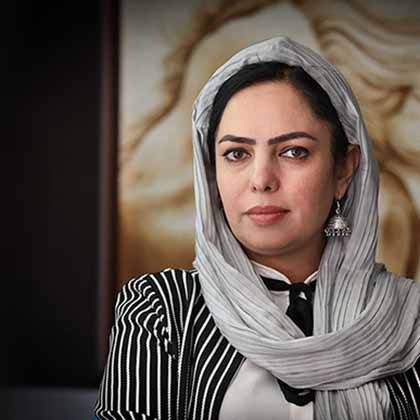
“This is the most dangerous time to be a journalist in Afghanistan. I confess that journalists are afraid, and they are really careful with their words.” — Anisa Shaheed, TOLOnews
Anisa Shaheed, TOLOnews (Hedayatullah for VOA News)
‘Voice for the world’
Afghanistan has rarely been safe for journalists, thanks to persistent conflict, lawlessness, and myriad warlords and militant groups. Still, the country has come a long way from the 1990s, when the Taliban ruled under a brutal Islamist code and the only Afghan-produced news came from Voice of Sharia, a radio station under its control.
“When Taliban were in power, there was no media. Everyone at the time used to listen to the BBC Pashto language broadcast on radio,” Shakeela Ibrahimkhel, a prominent Afghan journalist, told VOA.
Another journalist, who asked not to be named for security reasons, described it as “the dark age (when) no free press or media outlets were operating in the country.”
All that changed after the fall of the Taliban in 2001. A new constitution, formed in 2004, promised freedom of expression and the right to publish “without prior submission to state authorities.”
It also enshrined equal rights for men and women — a significant shift from Taliban rule, under which women had been blocked from education, work and politics.
This was a defining moment for Ibrahimkhel. “That’s when I realized no one in the world knew about our problems,” she said.

A female journalist interviews then-Foreign Minister Abdullah Abdullah in Kabul in 2002. Women took a central role in media after the fall of the Taliban in 2001. (Indranil Mukherjee | AFP)
Ibrahimkhel decided to become a journalist to be “a voice of our people to the world.” In 2004, she became one of the first female reporters to join Afghanistan’s first 24/7 news channel, TOLOnews.
When she started, it was still rare for women to work. Out in the field, men would stare at her or yell profanities. Police would not cooperate. But Ibrahimkhel was undeterred.
“After the fall of the Taliban, people, especially women, felt like they were released from prison,” she told VOA. “I felt a strange sense of relief and happiness.”
As dozens of local channels in multiple local languages spread across the country, and with a U.S.-backed government that supported freedom of the press, life became easier.
“Slowly things changed. People started understanding our role. Eventually, they started bringing their problems to us,” Ibrahimkhel said. “All of a sudden, it seemed like all the doors were open for me. Women got a lot of opportunities. I felt like I had a new life.”
That freedom included a responsibility to hold authorities to account.
“I started raising a voice against corruption and covering corruption of ministers and senior officials … so government officials started hating me,” Ibrahimkhel said. “The Taliban already hated me.”
Afghanistan now has a thriving media scene. Around one-sixth of its population of 38 million are active on social media, and the country has more than 100 newspapers and 170 radio stations, according to the Reuters Institute for the Study of Journalism.
Strong female voices in media have left an impact on younger generations.
Kabul anchor Shaheed, whom the newly established Free Speech Hub named its 2021 journalist of the year, says young girls look up to her and often say they want to be journalists, too.
“I tell them to study hard and not take any pressure from anyone,” Shaheed said. She appeals to families, especially male relatives, to support the ambitions of these girls.

Afghan media pictured in the aftermath of a blast in Kabul in April 2018. The double bombing killed nine journalists. (Omar Sobhani | Reuters)
A Taliban attack
Aspirations like those are inspiring, but the satisfaction is tempered by ever-present risk from targeted attacks or suicide bombings.
In perhaps the deadliest incident involving the country’s media, a double attack carried out by Islamic State group (IS) in 2018 killed nine journalists after a second bomber waited for media and first responders to arrive at the site of an initial blast before detonating his device.
In Ibrahimkhel’s case, a suicide bombing cut short her career with TOLOnews.
She was working the late afternoon shift in the station’s Kabul office in January 2016 when a colleague ran over, telling Ibrahimkhel to prepare breaking news for TV. A suicide bomb had targeted a minivan, killing several people from the same company.
As Ibrahimkhel started writing, another colleague ran over. The minivan was TOLO’s. The people killed — seven in all — were co-workers who had departed just minutes before.
Ibrahimkhel froze.
“All of us, all my colleagues in the office, sat like zombies. We couldn’t move. My father was calling me, and I couldn’t pick up the phone,” she recalled, the trauma still real even after five years.
The Taliban took responsibility and claimed Ibrahimkhel was among those killed. Desperate for information, her father started calling her co-workers, one of whom could confirm she was alive.
Realizing the country was no longer safe for her, Ibrahimkhel left for Europe.
The bombing happened as hundreds of thousands of Syrians and Afghans fleeing conflict were trying to make their way to Germany. Ibrahimkhel and her three teenage children joined them, making their way illegally on boat, on foot, and in overstuffed cars from Turkey to Bulgaria, then Serbia, and on to Hungary.
Ibrahimkhel said she paid traffickers thousands of euros and crossed to Bulgaria on a rainswept night in a tiny boat carrying 14 people.
She was scared for her children. “I felt incredibly guilty, so much so that I wanted to return to Turkey, but it was not possible,” she said. “By this time, we were almost done.”
Ibrahimkhel now lives in Frankfurt, where she freelances for public broadcaster Deutsche Welle’s Pashto and Dari language services.
If circumstances were different, she never would have left.
“I still want to go back and work. Even from here I am working for Afghanistan. But I am here to save my life,” Ibrahimkhel said. “I am a journalist but also a mother.”
Journalists murdered in Afghanistan
Source: Afghan Journalists Safety Committee (AJSC)
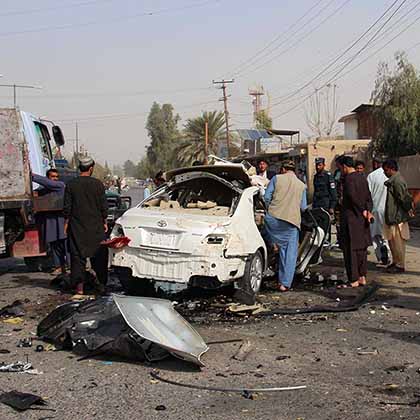
The wreckage of a car carrying Radio Free Europe/Radio Liberty reporter Elyas Dayee is seen in Lashkar Gar, Helmand province, on November 12, 2020, after a sticky bomb detonated, killing the popular journalist. (Noor Mohammad | AFP)
A deadly game
Many in Afghanistan believe the recent attacks are designed to silence voices calling for protection of human rights, civil liberties and free speech in any political deal.
In the on-again, off-again negotiations, both sides have submitted terms. The Afghan government wants protection of rights in the current constitution and an end to the violence. The Taliban demand immediate removal of foreign troops, release of thousands of prisoners and rule under their version of Islamic law.
But it’s a deadly game, with journalists caught in between.
“If a journalist is killed, the whole social media landscape, and mainstream media, and even the international media, gets filled with that news,” said Najib Sharifi, director of the AJSC.
The impact, he said, is “probably more valuable than killing a minister, if you look at it from the point of view of psychological warfare.”
The Afghan government and international community have condemned the attacks, blaming the Taliban.
“The Taliban must understand that their violent destructive actions outrage the world and must cease if peace is to come to Afghanistan,” read one of several joint statements issued by the U.S. and NATO.
But the Taliban deny responsibility. Their spokesperson, Mohammad Naeem, told VOA that claims the Taliban are behind killings or threats are “far from the truth.”
Andrew Watkins is a senior analyst for Afghanistan at International Crisis Group, a nonprofit that focuses on preventing wars. He said the evidence “clearly points to the Taliban” in many cases.
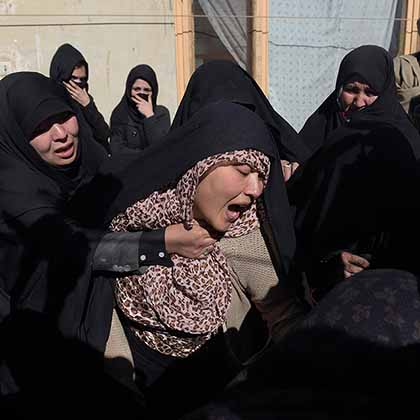
Relatives mourn at a funeral for one of the victims of a Taliban suicide attack that killed several employees of TOLOnews. (Shah Marai | AFP)
“Are Taliban denials of attacks on journalists considered legitimate? No,” Watkins said. Although other groups are also involved, he said, “the scale and scope of attacks targeting journalists could only be carried out by a group with national reach and organization.”
And while the Taliban leadership says one thing, Taliban supporters on social media appear to relish the bloodshed.
In one example, a Twitter user who posts pro-Taliban content tagged a number of media outlets in March with a post that read in Pashto: “Your pen is red with my blood, journalist. Your pen is blind to my screams, journalist.”
Although Kabul likes to blame them, the Taliban are not the only threat.
The Islamic State Khorasan Province (ISKP), a regional branch of the IS, claimed responsibility for the attacks on Enikass Radio and TV.
“ISKP has a history of false claims, but also a clear record of who they consistently target,” Watkins said. “Attacks against women, minority communities and progressive members of society all fall under the ISKP targeting list, and Jalalabad remains their most potent hub of activity.”
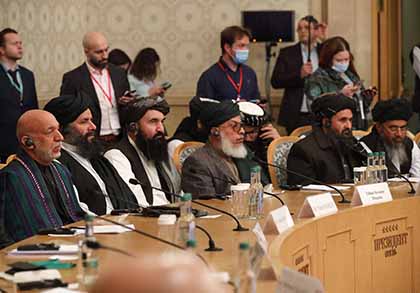
Former Afghan President Hamid Karzai, left, and Taliban co-founder Mullah Abdul Ghani Baradar, second from right, attend an international conference for a peaceful solution to the conflict in Afghanistan, hosted in Moscow in March 2021. (Alexander Zemlianichenko | POOL / AFP)
Is Ghani serious?
Afghan President Ashraf Ghani has described the killings as an “attack on freedom of speech and a crime against humanity” and ordered investigations that his office says are “either completed or are in the process.”
“The president has always stated that the rights of the journalists are guaranteed in the constitution, and he will always defend that. Anywhere, anytime,” Marjan Mateen, deputy communications director for the presidential palace, told VOA.
Journalists are skeptical. They say the government is not fully transparent when it comes to sharing updates on the investigations. “Their talk of protecting journalists is mostly rhetoric. There is not much meaning or substance to it,” said Sharifi, of the AJSC.
With a lack of support and amid rising threats, several female journalists, including high-profile reporters like Forotan, have either left the profession or their country.
Forotan hid for five days after the warning call. With the help of Amnesty International and the AJSC, she was able to reach Paris, and from there, the U.S. Her journey to safety was slowed by quarantine measures necessitated by the global pandemic.
Other newsrooms temporarily furloughed staff.
Broadcaster Enikass employed 10 women in a staff of about 80. After a shooting in March killed three of its employees, two quit, and the remaining women were advised to draw salaries but temporarily stay away.
“We are the leading station in this region, and we created a very good environment for women,” said Shukrullah Pasoon, the station’s head of broadcasting. “Even now, despite the threats, we are getting (resumes) of women journalists wanting to work with us, but we are not hiring due to the security situation.”
Pasoon believes the attacks were a response to the station’s coverage of ISKP, but, he said, the station has not changed its content.
When government forces took back control of Achin, a district in the south of the Nangarhar province, his team traveled there.
“(We) shot a one-hour program describing life after Daesh and how people suffered,” he said, using the Arabic acronym for the militant group. “Then we went to Pachir Agam, another stronghold of ISKP, and showed pictures of people and their suffering.”
Self-censor or evacuate
Parts of Nangarhar were the original stronghold for Islamic State in Afghanistan. The province, which is marginally bigger than Delaware and borders Pakistan, is now under government control, but IS still carries out attacks and still has followers in the region.
Government-held areas are considered safer, but the weak writ of the state leaves journalists vulnerable. Each province brings a different risk, and journalists say militants find ways to threaten them.
The result is self-censorship, which Sharifi said “undermines the very idea of journalism.”
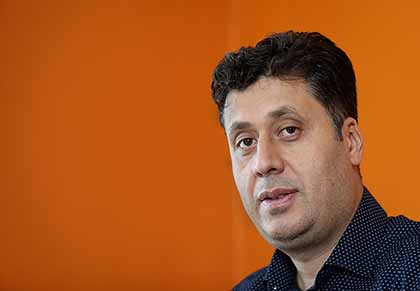
“If a journalist is killed, the whole social media landscape, and mainstream media, and even the international media, gets filled with that news.” — Najib Sharifi, director of the AJSC
(Hedayatullah for VOA News)
The chief editor of a prominent media organization attested to that, saying his outlet holds some stories back.
“(T)he Taliban raped and killed a woman in Jawzjan province. Keeping in mind the rise of attacks since peace negotiations started in Qatar, I decided not to publish,” said the editor, who asked for anonymity out of security concerns.
VOA could not independently verify details of the alleged attack.
Mostly we drop stories on the Taliban, the journalist said, adding that the outlet’s senior team will assess whether an incident is safe to cover. When members of the Taliban allegedly carried out a similar attack later that same month, the outlet covered it.
AJSC data show that the Taliban are responsible for 27 killings and 76 cases of media threats between 2013 and 2019. In comparison, the government is listed as responsible for two killings and 66 threats; and IS, for 21 fatal attacks.
Taliban spokesperson Naeem said it was a “far-fetched idea” that local commanders don’t tolerate critical reporting.
“Many journalists in local media not just criticize but also do propaganda against the Islamic Emirate. We still did not create any problems for them. If we wanted, we could create trouble for them, but it is not our policy,” he told VOA, using the Taliban’s term for itself.
The AJSC has evacuated dozens of journalists from Helmand, Ghazni, Kandahar and other provinces because of serious threats. Founded in 2010, the group monitors the severity of a threat and notes the location, the journalist’s gender, and whether he or she has covered any recent conflicts or criticism of the Taliban or IS.
“After that, you decide whether you need to evacuate or not,” Sharifi said.
But leaving is a tough call. Reporters know their absence means stories will go untold.
“I am not the only one suffering,” said Shaheed, who covers politics and human rights. Despite threats, she plans to stay. “Others in the society are also suffering. When they suffer, they come to me to tell their stories,” she said.
Shaheed’s 2016 interview with Ahmad Ishchi, a political rival of then-Vice President General Abdul Rashid Dostum, resulted in international coverage and criminal charges for Dostum after Ishchi accused the general of ordering his abduction and rape.
Dostum, who denies the allegations, fled to Turkey for more than a year. Charges against him remain active, but he has since returned to Afghanistan through a political deal that also granted him the country’s highest military rank.
‘No guarantees’
Afghanistan’s future remains unpredictable.
“I can’t make any guarantees about what will happen inside the country. No one can,” U.S. President Joseph Biden’s national security adviser, Jake Sullivan, said after his boss announced the troop pullout.
President Ghani’s spokesperson Mateen told VOA that the Afghan leader sees it as his “duty to support journalists” and cited government commissions on access to information and media safety.
“The constitution is the best legitimate source for the defense and protection of the journalists,” Mateen said.
Mohammad Masoom Stanekzai, head of the Afghan negotiation team, said the team has a “coherent strategy” to protect those values gained during the past 20 years, including a free and independent media.
“All rights and freedoms in our constitution will be respected, “ Stanekzai told VOA, adding that a free media “changes society positively and moves it toward development.”
The Taliban are “also benefiting (from) these rights and raising their voice through different media,” Stanekzai added.
In terms of press freedom, Taliban spokesperson Naeem told VOA that the group “will have an Islamic system of government in Afghanistan” that guarantees rights.
When asked if that would include space for critical media, Naeem said, “Criticism is the right of every person, but it should be done according to Islamic principles and national interest.”
Rights for women would be similarly permitted, he said, “as long as they follow the Islamic principles and our cultural values.”
Rights groups say the Taliban are already rolling back freedom of expression and access to education for women in areas they control. Journalists are doubtful that the group will change its ways.
Sharifi sees some tough choices coming after any peace deal.
“Currently, there is a lot of criticism of the government,” he said. “I don’t think we’ll have [that] then, because the Taliban will not tolerate that.”


